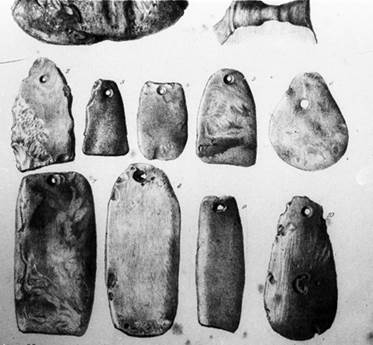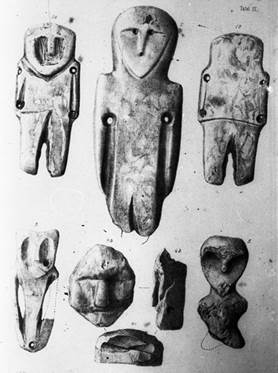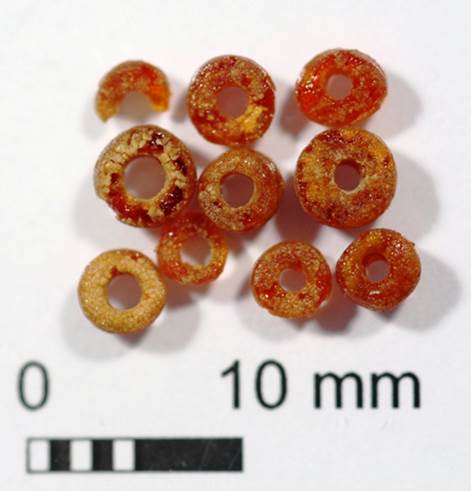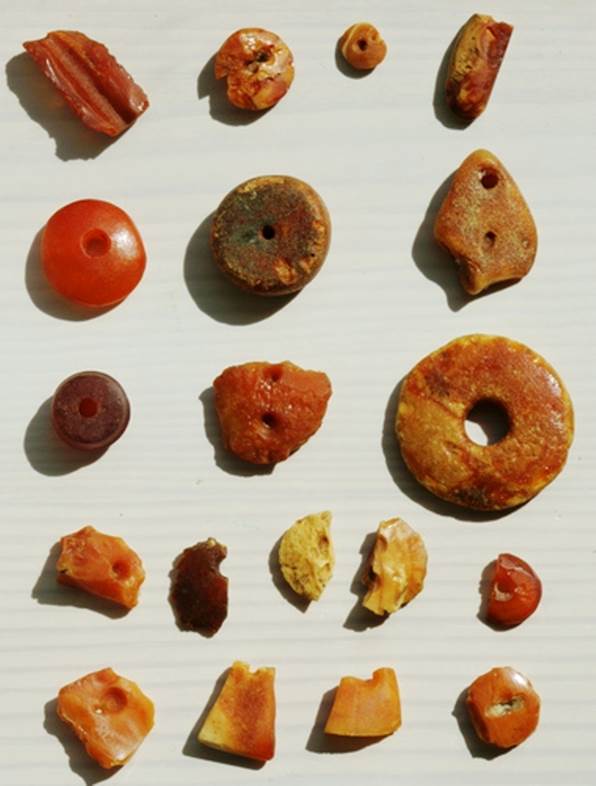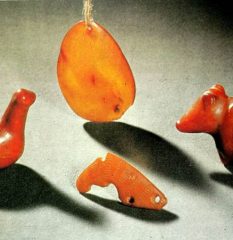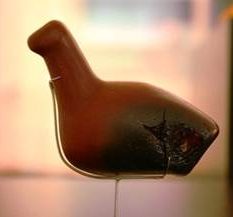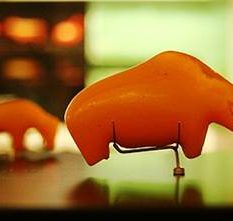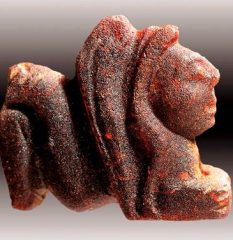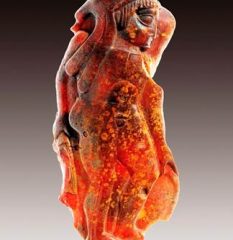Amber reached East Lithuania from the Baltic Sea shores, but it is found in quite distant from the sea places in the till deposit layers: at the shores of Širvinta River around Širvintos, near Kernavė, Gaurė, Lipniūnai, Utena, Lukšto and Plateliai lakes, River Nemunas shores (around Kaunas lagoon) near Pažaislis, around Alytus, at Strėva shores, in Kalviai region in Sandrava stream around Žaiginiai village and other places. There‘s no doubt that our ancestors used amber for jewellery and other needs in East Lithuania as well.
Amber burial shrouds are found at Aukštkiemių, Barvų, Kurmaičių, Gibaičių, Maudžiorų, Sargėnų, Seredžiaus, Stragnų, Šernų, Šilutės and other place barrows and flat burial grounds. At women‘s graves amber spindles were found – flat, quite thick or with double cut cone shape – also amber necklaces and bead holders. Though, I-IV century bead holders made mainly from amber weren‘t found; they‘re used together with brass strands or blue glass beads, sometimes even with enamel beads. Such twining from amber and blue glass beads was received for Šilutė ethno cultural museum and is exhibited in the Amber museum of Palanga.
Amber artifacts of the mentioned period were also found in Palanga at the current Baltic square not far from Ražė stream when researching II-IV 20 women graves. Together with other burial shrouds amber necklaces and pendants were found, too.
During the formation of class society (V-VIII century) amber jewelery production didn‘t diminish – actually amber necklaces of that period are found even more. Though, to adorn the neck brass and silver collars were used, but also and small twines made from various beads (as well as amber) and brass strings.
V-VIII century amber twines were found at the burial site of Rūdaičiai (Kretinga region); one of them is made out of 27 amber cone shaped beads. The same shape twine form 13 amber and 12 glass beads and several brass strings was found in Lazdininkai. Women of those times adorned themselves with irregular shaped amber necklaces. In order to show the museum visitors these decorations, a women‘s grave from V-VII century Eiguliai burial site (borrowed by National Museum of Kaunas) together with the bones, well preserved and wealthy burial cerements was exhibited. Here we saw 2 brass spoon-shaped collars, small, enamel covered and glass bead twine, 6 brass string bracelets, 4 brass string rings, spiral ring, elk or deer horns. Because at Eiguliai burial site No. 2 many necklaces were found and great part of them is amber, so to this grave on exhibition 14 irregular shaped flat amber necklaces were added from another woman‘s grave that didn‘t preserve so well.
Amber beads and beaded twinings, spindles were also found at these burial sites: Baitų, Eigulių, Griežėnų, Paklibakių, Panevėžiuko, Reketės, Rubokų, Uogučių, Upytės, Tūbausių, Žvirblių (New Vilnia). At Maudžoriai pendants reminding small stone axes were also found.
The archeological finds show that during the later Metal age (the time of early feudalism) West and Middle Lithuanians used amber widely. Together with blue glass bead and brass string twinings amber twinings were also very fashionable.
At the museum, a big double-cut cone-shaped twining of 45 amber beads is exhibited created out of 2 IX-XII centuries Paulaičių and Nikėlų burials‘ necklace twinings. The biggest bead is in the middle of the twining and they get smaller towards the ends. In 1966 the exposition was enlarged again by adding to it 30 various size amber bead necklaces found by ethnographers of the Švėkšna middle school during the 1957-1958 dig of the Nikėlai burial site. Also at Nikėlų, Paulaičių, Mockaičių and Skomantų burial sites 24 necklaces were found during the 1925-1941 dig. Similar twinings were worn mostly during X-XI centuries. They‘re found not only at Nikelėnai, but also at Paulaičiai, Švėkšna, Straganai and other.
At the late Metal and middle Brass Age an amber bead was sometimes inserted into the center of the twinings. The scope of amber usage for jewelery can partially be shown by the 300 amber beads found in a gravesite of IV-XII centuries at Aukštakiemiai (Klaipėda region).
Single amber beads were found in numerous Western and Middle Lithuania burial sites: Balsių, Dargalių, Dimitravo, Eketės mound, Gintališkės, Griaužų, Jauneikių, Juodsodės, Jurgaičių, Jurkiškių, Kuntaičių, Laivių, Lepšių, Linksmučių, Mockaičių, Pryšmančių, Rimaisų, Siraičių, Skomantų, Vilkų edge, Vėžaičių areas. Although amber wasn‘t only used for twinings in those days.
During a grave dig in Palanga during 1961-1962 Lithuanian TSR Science Academy archeologists found more than 270 men, women and children graves near the territory of „Gintaras“ (translates as „Amber“) hotel pine forest. They revealed many pages of the history of amber: besides the amber twinings they found 2-3 amber beads in the headbands of women and men as well. Men carried amber pendants in the form of combs on their belts, warrior spears and horse curbs were adorned with unpolished amber necklaces. When burying a woman a round plate of polished amber wrapped into a veil was put under her vertex, besides a polished amber spindle and sometimes natural amber pieces in a cup or a box. All of this was probably connected with still yet unknown customs that had magical meaning.
Young girls during the IX-XII century wore diadems and the hair was either loose or braided and the braids tightened with amber bead. Such double-cut cone-shaped flat bead was found in the VIII-XIII century Palanga graveyard during the 1961-1962 dig, it is thought that the end of the braid was put through such a bead to tighten it. A similar bead is exhibited at the Palanga collection.
The unique and never again found miniature artifacts are exhibited in this museum that had a symbolic meaning made especially for burials: a spindle with a handle, 4 square string winding plates and a knife to beat on the threads. There are real working tools at the exhibitions as well: amber spindles more than 4 cm wide and 1,5 cm thick from the IX-XII century burials at Mataičiai and Pagrybis, and XI-XII century Skomantų burials. The visitor can see analogical burial amber round plate and comb-shaped pendants at the Palanga museum that were found in VIII-XIII century Kiauleikiai burial site as well as beads that were found in Veršvai (VIII-XIII) and Griaužai (IX-XII) horse burial sites. 1-2 unpolished beads were woven into the horse‘s fringe. Amber beads were also found in the early feudal period Mikytų, Rimaisų, Ruseinių, and later on in 1963 at Pakalniškių (near Gelgaudiškis) horse burial sites. These horse adornments probably had some magical meaning.
The mentioned burial findings tell us that even at the first millennium Lithuanians used amber. In 1949 a Latvian archeologist L. Vankina at the Baltic seacoast location Sarnatia (north of Liepaja) found a amber polishing workshop of the late Neolithic-early Brass age where many flint fragments were also found together with many amber artifacts. At Sarnatia 387 unpolished amber pieces and 2900 amber slivers and pieces that were started to drill were found.
A Latvian archeologist I. Lozė near Luban lake Nainiekstė campsite found 218 amber adornment, 3000 unpolished pieces and slivers (many round buttons with V form drilling holes, cylindrical necklaces and other) 1964. She also collected the semi manufactures – unfinished necklaces, pendants (some with unfinished drilling holes, others still unpolished). Also a big part of flint drills and sandstone stones for polishing were uncovered.
When the irrigators were digging channels in 1966 South of Šventoji town in the great swamps local dwellers found artifacts of Stone Age camps. During 1967-1972 dig led by archeologist Dr. R, Rimantienė new archeological digs were done that gave as new data about the seashore dwellers‘ way of life.
 EN
EN LT
LT


